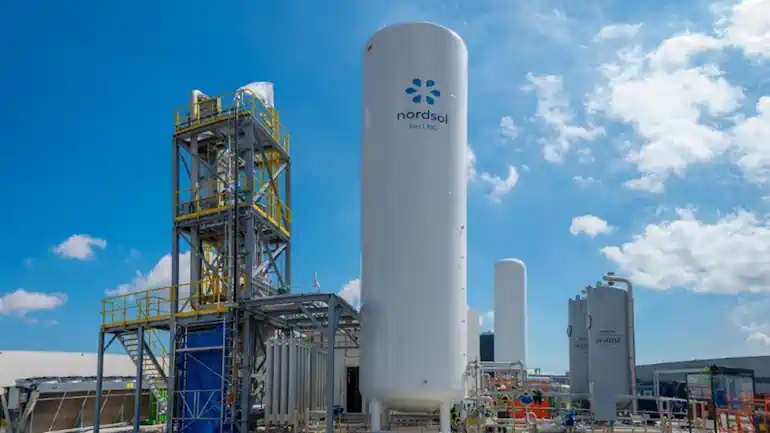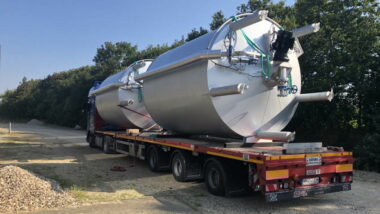Welcome to our blog about Bio LNG Production, this being our guide to Bio-Liquified Natural Gas manufacturing using the Anaerobic Digestion Process.

Is your business dealing with organic waste and looking for sustainable ways to convert it into valuable energy? You might find the answer in Bio-LNG, a renewable fuel derived from the anaerobic digestion (AD) of organic waste.
Is your business seeking ways to reduce your carbon footprint, and you run a fleet of heavy goods vehicles? Again, Bio-LNG might be your answer.
This guide will enlighten you about this fascinating way of transforming food and animal waste into high-value liquefied natural gas that can be used as an alternative to fossil fuels.
Ready to discover how bio-methane production turns ‘waste' into ‘worth'? Let's dive in!
Key Takeaways
- Bio – LNG is a renewable fuel source produced through the anaerobic digestion process, converting organic waste into biogas and then liquefying it.
- The production of bio – LNG helps reduce greenhouse gas emissions and contributes to a greener future by providing a clean fuel alternative.
- Bio-LNG has various applications, including as a sustainable fuel for long-haul transport vehicles, reducing air pollution and promoting cleaner transportation options.
- The economic advantages of bio-LNG production, such as cost-effectiveness and potential revenue streams, make it an attractive investment opportunity in the growing market for renewable fuels.
[boomdevs_toc]
Now let's start at the beginning of this explanatory guide with the source of the methane which is used in bio LNG production:
It Starts with Anaerobic Digestion and Biogas Production
Anaerobic digestion is the process by which organic matter such as food waste and animal waste is broken down in an oxygen-free tank to produce biogas.
What is anaerobic digestion?
Anaerobic digestion is a complex process that involves the breakdown of organic matter without the presence of oxygen. In this method, specific types of bacteria transform food waste and animal manure into biogas in an oxygen-free tank.
The resulting biogas consists mostly of methane and carbon dioxide, which can then be used as a source of renewable energy. Notably, this procedure isn't just theoretical but has practical applications in producing sustainable fuels like Bio-LNG.
Through anaerobic digestion, we harness biomethane from organic waste materials, presenting the immense potential for long-haul transport vehicles as fuel sources. This fascinating bioenergy production method holds future promise for reducing greenhouse gas emissions substantially.
The Biogas to “Bio LNG” production process
The production process of biogas involves several key steps:
- Organic matter, such as food waste or animal waste, is collected and stored in an oxygen-free tank at an optimum (warm to hot) temperature and mixed into a culture of methane-producing microorganisms.
- These “anaerobic bacteria” break down the organic matter into a mixture of gases, including methane (CH4) and carbon dioxide (CO2).
- This mixture, known as biogas, is captured and stored for further use.
- The captured biogas undergoes purification to remove impurities and increase its methane content.
- The purified biogas (biomethane) is then utilized for various applications, such as generating electricity or heating, but in this case, the biomethane is compressed and cooled to form liquid methane which is exactly equivalent to the fossil fuel “natural gas”.
This biologically sourced liquified natural gas is called Bio LNG (Bio-LNG or BioLNG).
Other uses of biogas
Biogas, produced through the anaerobic digestion process, has a wide range of applications. It can be used as a renewable energy source for heating or cooking in households and commercial buildings.
Additionally, biogas can be utilized to generate electricity and provide power for various industrial processes. But the best use of biogas is in the transportation sector where (until hydrogen fuel becomes cheaper) it benefits from biogas processed to become Bio LNG.
Not only can Bio LNG be used as fuel for vehicles. It is the only large-scale green fuel option, available without high costs, for many HGV duties. It is especially useful in areas where compressed natural gas (CNG) infrastructure exists, as it can replace the use of fossil fuel natural gas for the same purpose.
Moreover, biogas is often utilized in wastewater treatment plants to produce heat and electricity while reducing greenhouse gas emissions. This versatile and sustainable energy source also plays a crucial role in agricultural and food waste management and offers numerous environmental and economic advantages.
Bio-LNG: A Renewable Fuel Source
So to recap on the above: Bio-LNG is a sustainable and renewable fuel source that is produced through the liquefaction of biomethane, offering an effective way to reduce greenhouse gas emissions.
Definition and production process of bio-LNG
Bio-LNG, or bio-liquefied natural gas, is a renewable fuel source that is produced through the process of anaerobic digestion. During this process, organic matter such as food waste or animal waste (manure etc.) is broken down in an oxygen-free tank or tanks.
This results in the production of biogas, which is a mixture of methane and other gases. The biogas can then be upgraded and liquefied to produce bio LNG. It's important to note that bio-LNG is considered a sustainable energy option due to its production through anaerobic digestion, making it an environmentally friendly alternative to traditional fossil fuels.
Importance of bio-LNG in reducing greenhouse gas emissions
Bio-LNG plays a crucial role in reducing greenhouse gas emissions, making it an important renewable fuel source. Produced through the anaerobic digestion process, bio-LNG helps to minimize our carbon footprint and combat climate change.
By converting organic matter like food or animal waste into biogas and then upgrading it for liquefaction, we can create this sustainable energy option. With its potential applications in long-haul transport vehicles, bio-LNG offers a viable solution to reduce greenhouse gas emissions and move towards a greener future.
Applications of bio-LNG
Bio-LNG has a wide range of applications, making it a versatile and sustainable fuel source. One key application is in the transportation sector, where bio-LNG can be used as an alternative to diesel or gasoline.
This renewable fuel has the potential to power long-haul transport vehicles, reducing greenhouse gas emissions and promoting cleaner air quality. Additionally, bio-LNG can be utilized in industrial processes such as heating or electricity generation.
Its clean-burning properties make it an attractive option for industries aiming to reduce their carbon footprint. By harnessing the power of anaerobic digestion and converting biogas into LNG, bio-LNG offers a practical solution for various sectors seeking to transition towards more sustainable energy sources.
Setting up a Bio-LNG Plant
The process of establishing a bio-LNG production plant involves several crucial steps, from site selection to full operation. It is a complex yet rewarding venture that holds immense potential for sustainable energy production.
Curious to learn more? Keep reading to discover the key aspects of setting up a bio-LNG plant and how it contributes towards a greener future.
Steps involved in establishing a bio-LNG plant
- Identify suitable feedstock sources, such as food waste or animal waste.
- Conduct a feasibility study to determine the potential for bio-LNG production.
- Select an appropriate site for the plant, considering factors like proximity to feedstock sources and transportation routes.
- Obtain necessary permits and approvals from regulatory authorities.
- Design the anaerobic digestion system, including the oxygen-free tanks and biogas collection infrastructure.
- Install the necessary equipment, such as digesters, gas storage tanks, and upgrading facilities for liquefaction.
- Commission the plant and carry out initial testing to ensure smooth operation.
- Optimize the process by adjusting parameters like temperature, mixing, and retention time.
- Continuously monitor and maintain the plant's performance to maximize biogas production and bio LNG yield.
- Explore potential collaborations with energy companies or transport operators for off-take agreements or distribution partnerships.
Considerations for site selection and feedstock availability
Site selection and feedstock availability are crucial considerations when setting up a bio-LNG production plant. The location must have sufficient space for the plant infrastructure, including anaerobic digestion tanks, upgrading facilities, and storage tanks.
Additionally, it is essential to choose a site that has easy access to organic waste sources such as food waste or animal waste. This ensures a steady supply of feedstock for biogas production.
Proper evaluation of potential sites and reliable feedstock availability are key factors in the successful establishment and operation of a bio-LNG plant.
Pre-FID and full operation stages
Before a bio-LNG production plant can reach full operation, there are several stages that need to be completed. One of the first steps is the pre-FID (Final Investment Decision) stage, where all necessary permits and agreements are obtained.
This includes securing feedstock sources, evaluating site locations, and conducting feasibility studies. Once the project moves forward, construction begins on the anaerobic digestion system and biogas upgrading facilities.
The equipment is installed, and testing and commissioning take place to ensure everything is functioning properly. Finally, once all systems have been tested successfully, the plant enters into full operation with continuous production of bio-LNG.
Benefits of Bio-LNG
Bio-LNG production and use, offer significant environmental benefits, as it serves as a clean fuel that helps reduce greenhouse gas emissions and contributes to the goal of achieving carbon neutrality.
Under the EU's REPowerEU strategy bio LNg projects may attract government financial incentives.
Being a locally produced energy it also adds to energy security.
Environmental benefits of using bio-LNG as a clean fuel
Bio-LNG, produced through the anaerobic digestion process, offers significant environmental benefits as a clean fuel. By utilizing organic waste such as food or animal waste, bio-LNG production helps divert these materials from landfills and reduces methane emissions.
Methane, a potent greenhouse gas if allowed to escape into the atmosphere, is converted into bio-LNG, which results in a carbon-neutral fuel source. This renewable energy not only decreases our reliance on fossil fuels but also contributes to reducing overall greenhouse gas emissions.
Furthermore, bio-LNG can be used as an alternative fuel for long-haul transport vehicles, further mitigating air pollution and promoting sustainable transportation options. With its ability to reduce waste and lower emissions, bio-LNG stands out as an environmentally beneficial choice for clean fuel usage.
Economic advantages and business opportunities
Bio-LNG production offers significant economic advantages and exciting business opportunities. Firstly, the production of bio-LNG through anaerobic digestion presents a sustainable and cost-effective alternative to traditional fossil fuels.
By utilizing organic waste as feedstock, companies can reduce disposal costs while generating renewable energy. This not only helps in reducing greenhouse gas emissions but also provides potential revenue streams from selling bio-LNG as a clean fuel.
Moreover, the growing demand for sustainable energy sources creates a unique business opportunity for those involved in the bio-LNG industry. As governments worldwide set ambitious targets to reduce carbon footprints, there is increasing support for renewable fuels like bio-LNG.
Energy companies can capitalize on this trend by investing in bio-LNG plants and supplying pipeline-quality biomethane gas to various sectors such as transportation, manufacturing, and heating.
Conclusion to our Bio LNG Production Guide
In conclusion, bio LNG production through the anaerobic digestion process offers a sustainable and renewable fuel source that can significantly reduce greenhouse gas emissions. It has various applications, particularly in long-haul transport vehicles, and provides economic opportunities for businesses.
By utilizing organic waste through anaerobic digestion, we can harness the power of biomethane and contribute to a greener future.

Bio LNG Production FAQs
1. What is bio LNG production?
Bio LNG production refers to the process of manufacturing liquified natural gas (LNG) using anaerobic digestion, which involves breaking down organic materials in the absence of oxygen to produce biogas.
2. How does anaerobic digestion contribute to bio LNG production?
Anaerobic digestion is a biological process where microorganisms break down organic matter in an oxygen-free environment, producing biogas as a byproduct. This biogas can then be upgraded and processed into liquified natural gas (LNG) through further purification and cooling processes.
3. What are the benefits of bio LNG production?
Bio LNG production offers several advantages, including reducing greenhouse gas emissions compared to traditional fossil fuel-based LNG, utilizing renewable feedstocks such as agricultural waste or food waste, and contributing to the circular economy by repurposing organic materials that would otherwise go to landfill.
4. Is bio LNG production economically viable?
The economic viability of bio LNG production depends on factors such as feedstock availability, government incentives or subsidies for renewable energy projects, infrastructure development costs, and market demand for sustainable fuels. However, advancements in technology and increasing environmental regulations are making bio LNG an increasingly attractive option for both economic and sustainability reasons.





